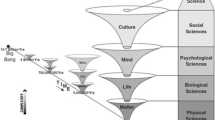Abstract
Human actor systems — individual and collective actors — are capable of an amazing variety of behavioral modes. While some of these modes clearly represent unreflected application of stored behavioral programs, and some result from random choices, others are obviously the end product of complex cognitive processes. This paper is concerned with the latter — here termed nonroutine behavior.
Access this chapter
Tax calculation will be finalised at checkout
Purchases are for personal use only
Preview
Unable to display preview. Download preview PDF.
Similar content being viewed by others
References
ANDREWS, F.M.: WITHEY, S. B. 1974: Developing Measures of Perceived Life Quality: Results from Several National Surveys. Social Indicators Research 1, 1–26.
ANDREWS, F. M. 1974: Social Indicators of Perceived Life Quality. Social Indicators Research 1, 279–299.
BOSSEL, H. 1976: Information Processing, Cognitive Dissonance, and
Basic Needs: The Modelling of Behavior. In: H. Bossel, S. Klaczko, N. Müller (eds.): Systems Theory in the Social Sciences, Birkhäuser, Basel.
CHRISTENSEN, B. L.; NORGAARD, J. S. 1974: Social Values and the Limits to Growth. Thayer School of Engineering, Dartmouth College, Hanover, N. H., DSD-17.
DALKEY, N. C. 1972: Studies in the Quality of Life. Delphi and Decision-Making. Heath, Lexington/Toronto/London.
GRÜMM, H.R. 1976: Definitions of Resilience. RR-76–5, International Institute of Applied Systems Analysis, Laxenburg, Austria.
HOLLING, C. S. 1973: Resilience and Stability of Ecological Systems. RR-73–3, International Institute of Applied Systems Analysis, Laxenburg, Austria.
MALLMAN, C. 1975: Quality of Life and Development Alternatives. Fundacion Bariloche, San Carlos de Bariloche, Argentina.
MASLOW, A. H. 1954/1970: Motivation and Personality. Harper and Row, New York, N.Y.
ROKEACH, M. 1973: The Nature of Human Values. Free Press, New York. THOM, R. 1975: Stability and Morphogenesis. Benjamin, Reading, Mass.
ZANGEMEISTER, C. 1975: Zur Methodik systemanalytischer Zielplanung -Dargestellt am Beispiel des Bildungsbereichs. Zentrum Berlin für Zukunftsforschung.
Editor information
Rights and permissions
Copyright information
© 1977 Springer Basel AG
About this chapter
Cite this chapter
Bossel, H. (1977). Orientors of Nonroutine Behavior. In: Bossel, H. (eds) Concepts and Tools of Computer-assisted Policy Analysis. Interdisciplinary Systems Research / Interdisziplinäre Systemforschung. Birkhäuser, Basel. https://doi.org/10.1007/978-3-0348-5570-9_7
Download citation
DOI: https://doi.org/10.1007/978-3-0348-5570-9_7
Publisher Name: Birkhäuser, Basel
Print ISBN: 978-3-7643-0921-3
Online ISBN: 978-3-0348-5570-9
eBook Packages: Springer Book Archive




